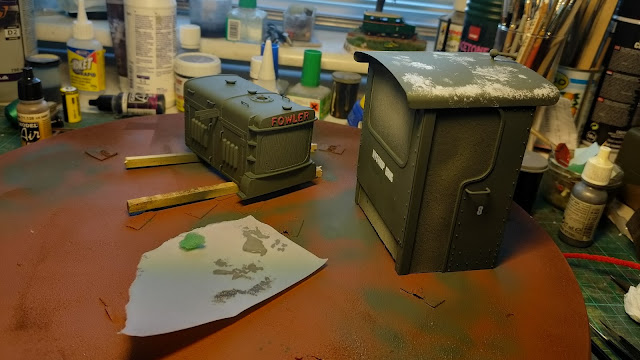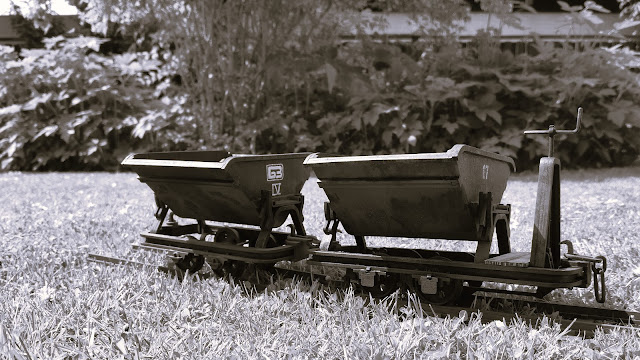As I had the box with 1/87 scale narrow gauge stuff out of the cupboard I could't resist placing one of the K-Model's MD-54-2 locos on the worktable. And in a couple of evenings 10-15 minutes of work took the model into the 'finished' category.
 |
| The little 1/87 scale MD-54-2 finished in an attempted landscape setting on my 1/19 scale layout. |
Despite the fact that the model is in all essence a finished model when bought, there is always something that can be changed, detailed or personalised. In this case the model also had to be repaired as a few lamps, exhaust and airfilter had broken off during travel from Kyiv. Once the repairs were done I added numbering to the cab sides from old transfers from a 1/35 scale military vehicle kit. Probably from the time when I taught modelling to youngsters (back in the beginning af the 1990's). The classes brought a lot of usefull leftovers that can still be used 40 years later.
 |
| The number '85' is in place on both sides of the cab. A slight fault in the old transfer could fortunately be fixed with use of decal solution and a scalpel. |
The very visible finaldrive for the chain transmission placed centrally between the axles is quite visible on the real MD-54-2. But on the model there is no representation of this part of the transmission. I made a very rudimentary construction of two pieces of plastic stock and glued it in place between the axles. Painted black it fills the empty space and no one but myself will probably notice the improvement. As the brush was out I also painted the metal wheels rust.
Once the paint on the finaldrive and wheels was dry I began weathering the loco with matt varnish with a little sand coloured paint added to it. The almost colourless mix was airbrushed in a very thin layer over the lower parts of the model and on horizontal surfaces to look like a layer of dust. Traces of rust and spilled fuel was applied as well as a general wash of heavily thinned black oil paint. In selected spots I added more dust.
 |
| The final layer of dust has been added and a soft pencil used to show wear on steps and exposed edges. |
 |
| The K-model loco is a nice little project to weather and detail with a few added parts. A worthwhile addition to my collection of Soviet narrow gauge locomotives. |
 |
| MD-54-2-85 was usually used for shunting at the Baranyvka mine. Here it has left for more scenic environment, the driver perhaps meeting with the two cyclists for a break? |
I'm now going large scale again to rest my tired eyes after working in 1/87. The difference in scale is easily noticed in the image below. The MD-54-2 in 1/87 is not much longer than an oil can in 1/19!
























.jpg)
